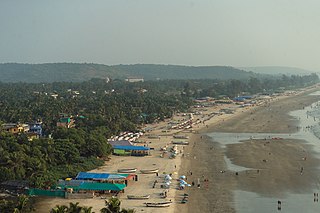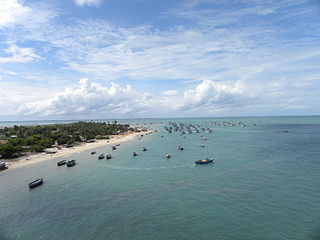
Mizoram is a state in northeastern India, with Aizawl as its seat of government and largest city. Within India's northeast region, it is the southernmost state, sharing borders with three of the Seven Sister States, namely Tripura, Assam and Manipur, and also shares a 722-kilometre (449 mi) border with the neighbouring countries of Bangladesh and Myanmar. The state spans over an area of approximately 21,087 square kilometres, of which approximately 91% is forested. With an estimated population of 1.25 million in 2023, it is the second least populous state in the country.

The Mizo National Front is a regional political party in Mizoram, India. MNF emerged from the Mizo National Famine Front, which was formed by Pu Laldenga to protest against the inaction of the Government of India towards the famine situation in the Mizo areas of the Assam state in 1959. It staged a major uprising in 1966, followed by years of underground activities. In 1986, it signed the Mizoram Accord with the Government of India, renouncing secession and violence. The MNF then began contesting elections and has formed state government in Mizoram three times. It is currently the state's opposition party, with its president, Zoramthanga, as the Former Chief Minister of Mizoram.

Arambol is a traditional fisherman village in the Pernem administrative region of North Goa, India, located 24.6 km (15.3 mi) north of Goa's capital city of Panaji. As of 2011, it has a population of around 5,300.

Ramanathapuram District, also known as Ramnad District, is one of the 38 districts an administrative districts of Tamil Nadu state in southern India. The old Ramanathapuram District consists of Present day Virudhunagar and Sivagangai districts, it touches the Western ghats and bordered with the state of Kerala and east by Bay of Bengal. It was the largest district on that time. The town of Ramanathapuram is the district headquarters. Ramanthapuram District has an area of 4,123 km2. It is bounded on the north by Sivaganga District, on the northeast by Pudukkottai District, on the east by the Palk Strait, on the south by the Gulf of Mannar, on the west by Thoothukudi District, and on the northwest by Virudhunagar District. The district contains the Pamban Bridge, an east–west chain of low islands and shallow reefs that extend between India and the island nation of Sri Lanka, and separate the Palk Strait from the Gulf of Mannar. The Palk Strait is navigable only by shallow-draft vessels. As of 2011, Ramanathapuram district had a population of 1,353,445 with a sex-ratio of 983 females for every 1,000 males. The district is home to the pilgrimage centre of Rameswaram and tourist spot Dhanushkodi, an abandoned town.

Byadagi chilli is a variety of chilli mainly grown in the Indian state of Karnataka. It is named after the town of Byadgi which is located in the Haveri district of Karnataka. It is sometimes written as Bedgi in some supermarkets and grocery stores in India. The business involving Byadagi chillis has the second-largest turnover among all chilli varieties of India. An oil, oleoresin, extracted from these chillies is used in the preparation of nail polish and lipstick. Byadagi chilli is also known for its deep red colour; it is less spicy and is used in many food preparations of South India. Byadagi chilli has been accorded Geographical Indication (GI) in February 2011. Its GI tag is 129.

Bikaneri bhujia, often simply called Bhujia, is a crispy snack prepared by using vigna aconitifolia, gram flour and spices, originating from Bikaner, a city in the western state of Rajasthan in India. It is light yellow in colour. Bhujia has become not just a characteristic product of Bikaner, but also a generic name.
Sirarakhong also called as Kampha is a village located west of Ukhrul in Ukhrul district, Manipur state, India. As per 2011 census, the village has a total of 202 households with 1243 persons of which 620 are male while 623 are female. Of the total population, 10.86% are in the age group of 0–6 years. The average sex ratio of the village is 1015 female per 1000 male which is higher than the state's average of 930. The literacy rate of the village is 95.22%.
The Naga Mircha is a variety of ghost pepper grown in the Indian state of Nagaland, belonging to the nightshade family Solanaceae. It is the first chilli or even the first of goods of any kind from Nagaland to be awarded a GI tag.
Mizo cuisine is the traditional cuisine of the Mizo people of Mizoram, India. Mizos are traditionally rice eaters.

Dalle Khursani, Akabare Khursani, red cherry pepper chilli or simply Dalle is a variety of chilli pepper primarily cultivated in Bhutan, Nepal, Indian state of Sikkim, and Darjeeling and Kalimpong districts of Indian state of West Bengal. Its pungency ranges between 100,000 and 350,000 SHU, similar to the Habanero chilli pepper.

The Khola chilli is a variety of chilli mainly grown in the Indian state of Goa.
The Harmal chilli is a variety of chilli mainly grown in the Indian state of Goa.

The Bhiwapur chilli is a variety of chilli mainly grown in Nagpur district, of the Indian state of Maharashtra.

The Ramanathapuram Mundu chilli is a variety of dry red chilli mainly grown in Ramanathapuram district, of the Indian state of Tamil Nadu. It is primarily grown in the Ramanathapuram district's Tiruvadanai, Mudukulathur, Kadaladi, RS Mangalam and Kamuthi taluks.

The Edayur chilli is a variety of chilli mainly grown in the Indian state of Kerala. The Edayur chilli is a local cultivar primarily grown in specific regions of Kerala's Malappuram district. Specifically, it is cultivated in the panchayaths of Edayur, Athavanad, Marakkara, Irimbiliyam, Kalpakanchery, and Valanchery within the Valanchery block, as well as Moorkanad and Kuruva panchayaths within the Angadippuram block.
The Sirarakhong Hathei chilli is a variety of chilli mainly grown in the Indian state of Manipur. It is widely cultivated crop in Sirarakhong village in the Ukhrul district of Manipur.

The Banaras Lal Bharwamirch (Red Pickle Chilli) is a variety of chilli grown in the Indian state of Uttar Pradesh. It is mainly cultivated in Varanasi, Azamgarh, Jaunpur, Ghazipur & Ballia districts of Uttar Pradesh.
The Nandurbar Mirchi is a variety of chilli grown in the Indian state of Maharashtra. It is mainly cultivated in Nandurbar & Dhule districts of Maharashtra.

The Almora Lakhori Mirchi is a variety of chilli grown in the Indian state of Uttarakhand. It is Uttarakhand's favourite home-grown chilli.
The Goan cashew refers to the variety of the Cashew fruit grown in the Indian state of Goa, which is one of the major Cashew-growing Indian states.In the entire state of Goa, the cashew crop spans approximately 55,302 hectares, yielding an estimated 27,070 tonnes annually. Goa Kaju or Goa Caju are variations of the same name.












